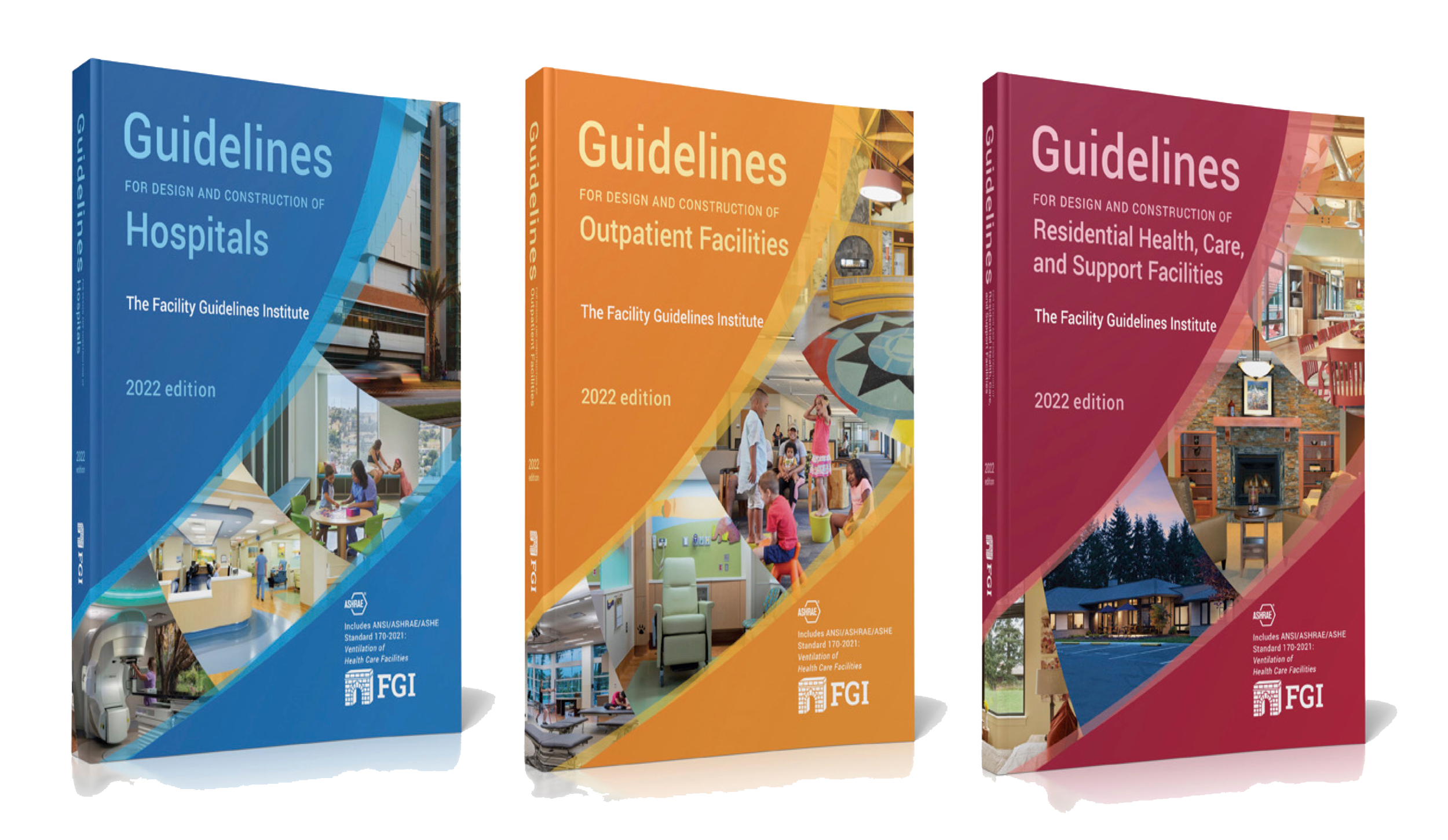Blog Contribution by NIHD member Brooke Karlsen, MSN, BSN, RN, NEA-BC, EDAC.
For those not already familiar with Facility Guidelines Institute (FGI), it is an independent, not-for-profit organization dedicated to developing guidance for the planning, design, and construction of hospitals, outpatient facilities, and residential health, care, and support facilities. FGI oversees the four-year revision process and publication of the Guidelines for Design and Construction documents. FGI partners with numerous other organizations to develop the Guidelines as well as other evidence-informed publications.
The Guidelines documents have a wide variety of public and private uses, including adoption by states for regulatory purposes and other reference in laws, codes, rules, and regulations, and use in private self-regulation. It is important to note that the Guidelines provide minimum standards. The HGRC uses research, science, and expert opinion to set criteria, providing baseline requirements vetted through an open consensus process. They are enforceable by the adopting federal and state agencies, not by FGI itself.
History of the Guidelines.
The Guidelines have a long history, first as a federal, then, privately written document starting originally back in 1947, as General Standards, for implementing regulations for the Hill-Burton Act. In 1974 it was retitled and for the first-time, public input was requested. After 1984, with the end of federal regulations under the Reagan administration, the Guidelines was initially published under the AIA andin 1998 FGI was formed. It has evolved the documents over time into three separate published documents: the hospital, the outpatient, and the residential documents. All three generally follow the same basic structure and outline
State Adoption of the Guidelines.
Interestingly, not all states in the US adopt the Guidelines. Some states do not adopt the standards at all or use them only as reference. Others may mandate adherence to older versions. Many keep current as each edition is released. The individual states’ health department licensing entity is the Authority Having Jurisdiction (AJH) and they assure health and residential care facilities follow requirements in the adopted edition of the Guidelines. The Joint Commission, and many federal agencies use the Guidelines documents either as a code or reference standard when reviewing, approving, financing, licensing, certifying, or accrediting newly constructed facilities. The Guidelines are used internationally as well. An adoption map can be found on FGI’s website (www.fgiguidelines.org). When reviewing the map on the website, if you hover the cursor over a specific state, you can learn how that state uses the Hospital, Outpatient, and Residential Guidelines—which edition, what facility types are covered, and more.
The Health Guidelines Revision Committee (HGRC).
The HGRC is the select multidisciplinary body of clinicians, administrators, architects, engineers, and state and local AHJs, that is convened every four years to revise and update the three documents. The goal is to make sure the Guidelines support quality design, accurately reflect how health and residential care is being provided and remain current with industry practice. All HGRC members volunteer their time. The organization is independent of manufacturer sponsorships and service on the committee. The HGRC evaluates proposals for change received from the public, creates topic and task groups for specific priorities to perform in-depth review of particular sections, and develops proposed revisions to the previous edition.
Clinicians, specifically nurses practicing in the built environment, have a unique perspective to bring to the HGRC and increasingly the HGRC has been including nurses. In short, the HGRC’s mission is to “Create documents, using an interdisciplinary consensus process advised by research, that can be used to design an advanced, cost-effective, high-quality built environment for the health care community.”
In this cycle the HGRC is made up of 137 members, divided among the document groups with the Hospital membership the largest at 65 people, the Outpatient group at 43 people, and the Residential group at 29. Returning members to the HGRC are selected based on the impact on and commitment to previous cycles and alignment to 2026 priorities. New members were selected based on their interest, professional background and affiliations, and alignment to the 2026 priorities. There is increasing diversity in terms of professional backgrounds and tenure and for the Outpatient document members, 9 are architects, 14 are owners, 8 are clinicians, 5 represent AHJs, 3 are from construction/delivery, 3 are engineers, and there is a governmental representative. Some have served for one or as many as 5 previous cycles, and almost half are new.
The Revision Process.
The four-year revision cycle process follows very specific steps. HGRC members participate through 3 several-days-long, in-person meetings; regularly scheduled virtual calls; document group voting; refining changes; and reviewing and voting on proposals to address things that users do not like about the Guidelines or find unworkable, impractical, below a minimum standard, or too high a standard.
In addition to the HGRC, members of the public (and all of you) have several opportunities to participate in the Guidelines revision process. Approximately one year after release of the previous edition, the public (including the HGRC) is invited to submit proposals to change the Guidelines documents. This opportunity began on February 1, 2023, and will run through June 30, 2023. Approved proposals will be presented in a draft manuscript of the next edition.
After conclusion of this public proposal period, the draft manuscripts of the next editions are released for a second public review and comment period. New proposals are not accepted during this second public comment period, and comments need to be specific to the revised content only. So, it is critical—if you have something you want to change or add—to get it in now. As FGI seeks more input from those who utilize the Guidelines in their professional capacity, NIHD members are encouraged to formulate and make proposals.
Submitting a Proposal.
FGI has attempted to make this as easy as possible through an online portal at www.fgiguidelines.net/login. When you select the site, the online portal pops up and you either sign up as new user or login if you have done this and you are going back in to work on something you previously initiated. Once inside, the portal guides you through the three steps to submit a proposal. In addition to submitting full proposals, one can also submit “opinions” on other proposals that have been entered, particularly if you see that someone has already submitted a proposal similar to what you plan to submit. There are downloadable written and video tips and tutorials to assist you with writing and submitting proposals. A solid substantiation or rationale must be included in your proposal. Once the proposal period closes, the HGRC will review and vote on the proposals and those reaching at least 2/3 consensus will be added into the 2026 draft documents to be commented on and voted on in subsequent cycles.




